Some daily sky sights among the ever-changing Moon, planets, and stars.
The slow nova in the Sagittarius Teapot, nearly three months old now, continues to rise and dim by a magnitude or more every two weeks or so on top of a gradual fading trend. As of June 8th it was about magnitude 6.7. See article with charts and a link to an up-to-date light curve.
Friday, June 5
With June under way, the Big Dipper swings around to hang down by its handle high in the northwest during evening. The middle star of its handle is Mizar, with tiny little Alcor right next to it. On which side of Mizar should you look for Alcor? As always, on the side toward Vega! Which is now shining in the east-northeast.
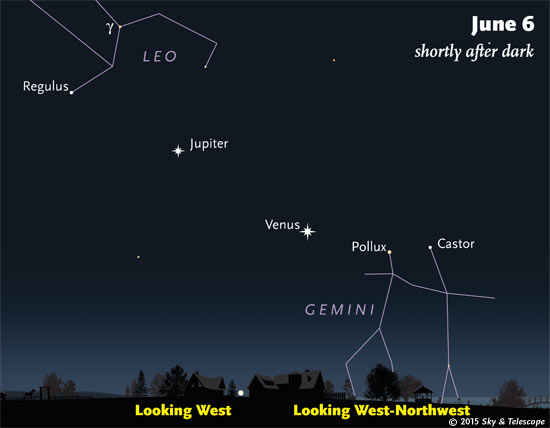
Saturday, June 6
At nightfall, Jupiter and Venus form a big, graceful sweep with Regulus to their upper left and Pollux and Castor to their lower right, as shown above.
With the evening sky moonless this week, ambitious users of big scopes under very dark skies can take on the challenge of the Corona Borealis galaxy cluster — a staggering 1.1 billion light-years away — using Howard Banich's guide in the June Sky & Telescope, page 60. The cluster's two brightest galaxies, a pair of giant ellipticals, are only magnitude 15.4.
Sunday, June 7
Saturn is the brightest point glowing in the southeast after dark this month. The stars of upper Scorpius glitter below it.
For instance, to the the lower left of Saturn by 3½° this week (about two finger-widths at arm's length) is Beta Scorpii, a fine double star for telescopes. Just 1° below that is the very wide naked-eye pair Omega1 and Omega2 Scorpii, not quite vertical. Binoculars may show their slight color difference. To Beta's left by 1.6° is Nu Scorpii, another fine telescopic double. And high power in good seeing reveals that Nu's brighter component is itself a close binary, separation 2 arcseconds.
Monday, June 8
As the stars come out, Arcturus stands very high almost straight above Saturn in the southeast. Find the midpoint of the Arcturus-Saturn line, and from that point look right. There's Spica.
Tuesday, June 9
Last-quarter Moon (exact at 11:42 a.m. EDT). The Moon doesn't rise tonight until 1 or 2 a.m., when its misshapen form emerges due east to the lower right of the Great Square of Pegasus.
Wednesday, June 10
Can you see the big Coma Berenices star cluster? Does your light pollution really hide it, or do you just not know exactly where to look? It's currently high in the west; look 40% of the way from Denebola (Leo's tail) to the end of the Big Dipper's handle (Ursa Major's tail). Its brightest members form an inverted Y. The cluster is about 5° wide — a big, dim glow in at least a moderately dark sky. It nearly fills a binocular view with its sparsely scattered points.
Thursday, June 11
It's just 10 days to official summer, but can you still see cold-weather Capella? As the stars come out, Capella still twinkles low in the northwest (if you live at a latitude north of mid-Florida).
Start by spotting the Big Dipper very high in the northwest as early as you can in twilight. It's hanging bowl down. Drop a line down from the Dipper's bowl to find Capella.
Friday, June 12
The two brightest stars high on June evenings are Arcturus, way overhead toward the southwest, and Vega, the brightest high on the eastern side of the sky. They're relatively close to us: 37 and 25 light-years, respectively. Vega's surface is more than twice as hot as Arcturus's surface (absolute temperature 9,600 kelvin, compared to 4,300 for Arcturus). Which is why Vega shines pale bluish white and Arcturus is pale yellow-orange.
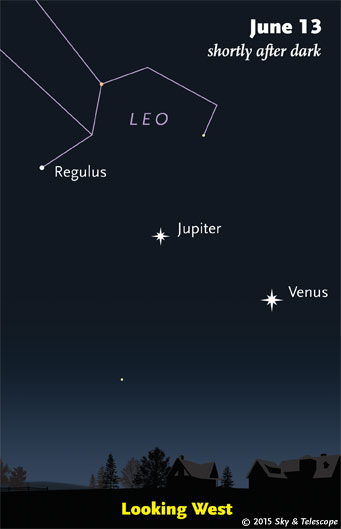
Saturday, June 13
Jupiter and bright Venus have closed to within 11° of each other in the west at nightfall. Once the sky is dark enough, binoculars can show that Venus this evening shines barely within the top fringe of M44, the Beehive Star Cluster.
__________________________
Want to become a better astronomer? Learn your way around the constellations. They're the key to locating everything fainter and deeper to hunt with binoculars or a telescope.
Once you get a telescope, to put it to good use you'll need a detailed, large-scale sky atlas (set of charts). The standards are the little Pocket Sky Atlas, which shows stars to magnitude 7.6; the larger and deeper Sky Atlas 2000.0 (stars to magnitude 8.5); and once you know your way around, the even larger Uranometria 2000.0 (stars to magnitude 9.75). And read how to use sky charts with a telescope.
You'll also want a good deep-sky guidebook, such as Sue French's Deep-Sky Wonders collection (which includes its own charts), Sky Atlas 2000.0 Companion by Strong and Sinnott, the bigger Night Sky Observer's Guide by Kepple and Sanner, or the beloved if dated Burnham's Celestial Handbook.
Can a computerized telescope replace charts? Not for beginners, I don't think, and not on mounts and tripods that are less than top-quality mechanically (able to point with better than 0.2° repeatability, which means fairly heavy and expensive).
This Week's Planet Roundup
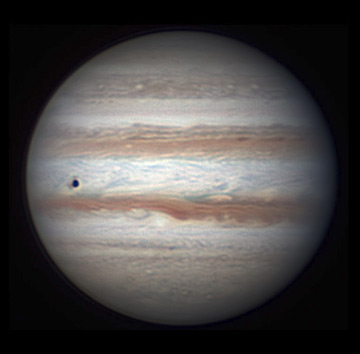
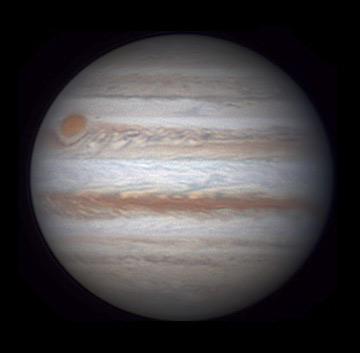
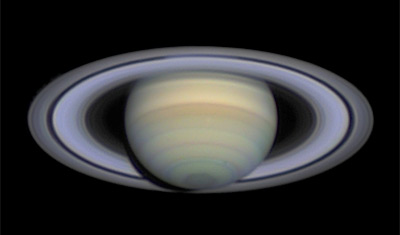
Mercury is hidden deep in the glow of sunrise.
Venus (magnitude –4.4, in Cancer) is the brightest point in the west during and after twilight. It doesn't set in the west-northwest until an hour after dark. In a telescope, Venus now is barely on the crescent side of dichotomy ("half-moon" phase).
Mars is hidden behind the glare of the Sun.
Jupiter (magnitude –1.9, at the Cancer-Leo border) is the bright white point to the upper left of Venus. These two brightest planets are closing in toward each other day by day: from 17° apart on June 7th to 12° apart on the 12th. They're heading toward a spectacularly close conjunction (1/3° apart!) on June 30th.
In a telescope, Jupiter has shrunk to 34 arcseconds wide, nearly as small as it ever appears.
Saturn (magnitude +0.1, just above the head of Scorpius) is a couple weeks past opposition. It's well up in the southeast in twilight now and highest in the south before midnight. Some 12° lower left of Saturn is twinklier orange Antares, less bright. In a telescope, Saturn's rings are tilted a broad 24° from edgewise.
Uranus (magnitude +5.9, in Pisces) is low in the east before dawn begins to brighten.
Neptune (magnitude +7.9, in Aquarius) is in the southeast before the first light of dawn.
__________________________
All descriptions that relate to your horizon — including the words up, down, right, and left — are written for the world's mid-northern latitudes. Descriptions that also depend on longitude (mainly Moon positions) are for North America.
Eastern Daylight Time (EDT) is Universal Time (UT, UTC, or GMT) minus 4 hours.
__________________________
“This adventure is made possible by generations of searchers strictly adhering to a simple set of rules. Test ideas by experiments and observations. Build on those ideas that pass the test. Reject the ones that fail. Follow the evidence wherever it leads, and question everything. Accept these terms, and the cosmos is yours.”
— Neil deGrasse Tyson, 2014.
 0
0
Comments
You must be logged in to post a comment.